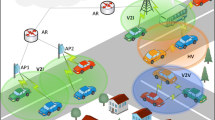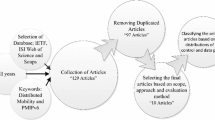Abstract
With the rapid growth in the number of mobile devices, such as cellular phones, PDAs and laptops, the need for seamless and ubiquitous Internet connectivity is tangible. Vehicular ad-hoc network (VANET) is a rapidly developing technology, which makes vehicle-to-vehicle and vehicle-to-infrastructure communication feasible. However, when a vehicle travels from one point of attachment to another, handoff delays and provision of seamless connectivity are considered as important issues. Ubiquitous and integrated Internet connectivity can be achieved if on road moving vehicles are connected. However, when vehicle density is small and/or vehicle velocities are different, end users may suffer from a high level of connection failure. IP mobility protocols are designed by Internet Engineering Task Force to provide acceptable levels of continuous Internet connectivity, maintaining mobile node communications as they travel amongst points of attachments. However, the current IP mobility approaches applied on VANET did not resolve the connection failure issues efficiently. Therefore, in this paper a new effective solution is proposed in order to eliminate the large amount of handover latency and eventually high packet loss ratio.










Similar content being viewed by others
References
Macker, J. (1999). Mobile ad hoc networking (MANET): Routing protocol performance issues and evaluation considerations. RFC 2501, Network Working Group. http://www.ietf.org/rfc/rfc2501.txt.
Martinez, F. J., et al. (2011). A street broadcast reduction scheme (SBR) to mitigate the broadcast storm problem in VANETs. Wireless personal communications, 56(3), 559–572.
Bohlooli, A., & Jamshidi, K. (2012). A GPS-free method for vehicle future movement directions prediction using SOM for VANET. Applied Intelligence, 36(3), 685–697.
Perkins, C. (2002). IP mobility support for IPv4. RFC 3344, Internet Engineering Task Force (IETF). http://www.ietf.org/rfc/rfc3344.txt.
Johnson, D., Perkins, C., & Arkko, J. (2004). RFC 3775: Mobility support in IPv6. IETF.
Koodli, R. (2005). Fast handovers for mobile IPv6. RFC 4068, Internet Engineering Task Force (IETF). http://www.ietf.org/rfc/rfc4068.txt.
Soliman, H., Bellier, L., & Malki, K. E. (2005). Hierarchical mobile IPv6 mobility management (HMIPv6). RFC 5380, Internet Engineering Task Force (IETF). http://tools.ietf.org/html/rfc5380.
Gundavelli, S., et al. (2008). Proxy mobile ipv6. RFC 5213, Internet Engineering Task Force (IETF). http://tools.ietf.org/html/rfc5213.
Devarapalli, V., et al. (2005). Network mobility (NEMO) basic support protocol. RFC 3963.
Moravejosharieh, A., Salleh, R., & Modares, H. (2011). A novel approach for efficient resource consumption in GPS-based mobile IPv6 wireless LAN. IEEE.
Moravejosharieh, A., Salleh, R., & Modares, H. (2011). Overview of latest approaches in heterogeneous and mobile IPv6 homogeneous wireless networks based on location-assisted information. IEEE.
Moravejosharieh, A., Salleh, R., & Modares, H. (2012). Overview of handover latency and resource consumption in hierarchical mobile IPv6 protocol and GPS approaches. IEEE.
Amirhossein Moravejosharieh, R. S. (2012). Geometrical GPS optimization for bandwidth consumption and resource usage in MIPv6 wireless LAN. International Journal of Scientific and Engineering Research (IJSER), 3(6), 1–12.
Arnold, T., et al. (2008). IP address passing for VANETs. IEEE.
Fazio, M., et al. (2007). Facilitating real-time applications in VANETs through fast address auto-configuration. In Proceedings of IEEE CCNC/NIME.
Fazio, M., et al. (2006). Automatic IP address configuration in VANETs. ACM.
Mohandas, B. K., & Liscano, R. (2008). IP address configuration in VANET using centralized DHCP. IEEE.
Chen, Y. S., Hsu, C. S., & Yi, W. H. (2012). An IP passing protocol for vehicular ad hoc networks with network fragmentation. Computers & Mathematics with Applications, 63(2), 407–426.
Chen, Y.-S., Hsu, C.-S., & Yi, W.-H. (2012). An IP passing protocol for vehicular ad hoc networks with network fragmentation. Computers & Mathematics with Applications, 63(2), 407–426.
Chen, Y. S., et al. (2009). Network mobility protocol for vehicular ad hoc networks. IEEE.
Lee, J. M., et al. (2008). A new scheme of global mobility management for inter-vanets handover of vehicles in v2v/v2i network environments. IEEE.
Chiu, K. L., Hwang, R. H., & Chen, Y. S. (2009). Cross layer design vehicle aided handover scheme in VANETs. Wireless Communications and Mobile Computing, 11(7), 916–928.
Lai, P., et al. (2009). A reliable broadcast routing scheme based on mobility prediction for VANET. In Intelligent vehicles symposium, IEEE2009 (pp. 1083–1087). IEEE.
Lee, J.-C., & Kaspar, D. (2007). PMIPv6 fast handover for PMIPv6 based on 802.11 networks. IETF draft-lee-netlmm-fmip-00 (July 2007).
Lin, S. H., et al. (2009). A novel social cluster-based P2P framework for integrating VANETs with the Internet. IEEE.
Sheu, J. P., Tu, S. C., & Chan, L. H. (2008). A distributed IP address assignment scheme in ad hoc networks. International Journal of Ad Hoc and Ubiquitous Computing, 3(1), 10–20.
Siddiqui, F., & Zeadally, S. (2008). An agent-based architecture for fast context transfers during handoffs. International Journal of Ad Hoc and Ubiquitous Computing, 3(4), 236–244.
Li, R., et al. (2008). An enhanced fast handover with low latency for mobile IPv6. IEEE Transactions on Wireless Communications, 7(1), 334–342.
Shin, D., & Min, S. (2008). Fast handover solution using multi-tunnel in HMIPv6 (FM-HMIPv6). IEEE.
Obele, B. O., Rhee, J. K., & Kang, M. (2008). A proposal for reducing handover latency and improving route optimization in proxy mobile ipv6. IEEE.
Lee, J. C., & Park, J. S. (2008). Fast handover for proxy mobile IPv6 based on 802.11 networks. IEEE.
Hwang, H., et al. (2010). Fast handoff scheme using multicast group for intra-domain in PMIPv6 networks. IEEE.
Moon, S. D., et al. (2011). Fast handover with low latency for proxy MIPv6 in vehicular networks. ACM.
Kim, J. I., & Koh, S. J. (2011). Proxy Mobile IPv6 with partial bicasting for seamless handover in wireless networks. IEEE.
Cristea, V., et al. (2009). Simulation of VANET applications. Automotive Informatics and Communicative Systems. doi:10.4018/978-1-60566-338-8.ch014.
Author information
Authors and Affiliations
Corresponding author
Rights and permissions
About this article
Cite this article
Moravejosharieh, A., Modares, H. A Proxy MIPv6 Handover Scheme for Vehicular Ad-hoc Networks. Wireless Pers Commun 75, 609–626 (2014). https://doi.org/10.1007/s11277-013-1381-8
Published:
Issue Date:
DOI: https://doi.org/10.1007/s11277-013-1381-8




